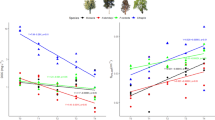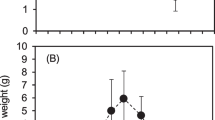Abstract
We examined the effect of light on extracellular enzyme activities of periphytic/endogenous microbial assemblages associated with decomposing litter of an emergent macrophyte Typha angustifolia within a small inland wetland in southeastern Michigan. Standing-dead Typha leaf litter was collected, placed into floating wire mesh litter baskets, and submerged in a wetland pool. Enzyme saturation assays were conducted on three occasions following litter submergence (days 9, 28, and 44) to generate saturation curves for the individual enzymes tested and to examine potential differences in enzyme saturation kinetics during microbial colonization and development. Experimental light manipulations were conducted on two occasions during microbial development (days 10 and 29). Short-term (30 min) light exposure significantly increased extracellular β-glucosidase activity of litter-associated microbial communities. Activities of β-xylosidase and leucine-aminopeptidase were not stimulated, and stimulation of phosphatase activity was variable. The exact mechanism for increased enzyme activity remains unknown, but it may have been increased pH arising from periphytic algal photosynthesis. These results suggest that extracellular enzyme activity in microbial communities colonizing natural organic substrata may be influenced by light/photosynthesis, as has previously been demonstrated for periphyton communities grown on artificial, inert substrata. Thus, light/photosynthetic mediated stimulation of extracellular enzyme activities may be a common occurrence in microbial communities associated with natural decaying plant litter in wetlands and might engender diurnal patterns in other microbial decay processes (e.g., production, organic matter decomposition, and mineralization).


Similar content being viewed by others
References
APHA (1992) Standard Methods for the Examination of Water and Wastewater, 18th edn. American Public Health Association, Washington, DC
Bärlocher, F (1985) The role of fungi in the nutrition of stream invertebrates. Bot J Linn Soc 91: 83–94
Biggs, BJF (1990) Use of relative specific growth rates of periphytic diatoms to assess enrichment of a stream. NZ J Mar Freshw Res 24: 9–18
Biggs, BJF (1987) Effects of sample storage and mechanical blending on the quantitative analysis of river periphyton. Freshw Biol 18: 120–197
Biggs, BJF, Kilroy, C (2000) Stream Periphyton Monitoring Manual. New Zealand Ministry for the Environment/NIWA, Christchurch, New Zealand
Burkholder, JM, Wetzel, RG (1989) Microbial colonization on natural and artificial macrophytes in a phosphorus-limited, hardwater lake. J Phycol 25: 55–65
Carlton, RG, Wetzel, RG (1988) Phosphorus flux from lake sediments: effect of epipelic algal oxygen production. Limnol Oceanogr 33: 562–570
Chróst, RJ (1991) Environmental control of the synthesis and activity of aquatic microbial ectoenzymes. In: Chróst, RJ (Ed.) Microbial Enzymes in Aquatic Environments, Springer-Verlag, New York, pp 29–59
Chróst, RJ, Overbeck, J (1987) Kinetics of alkaline phosphatase activity and phosphorus availability in for phytoplankton and bacterioplankton in lake Pluβsee (north German eutrophic lake). Microb Ecol 42: 328–337
Chróst, RJ, Rai, H (1993) Ectoenzyme activity and bacterial secondary production in nutrient-impoverished and nutrient-enriched freshwater mesocosms. Microb Ecol 25: 131–150
Cummins, KW (1974) Structure and function of stream ecosystems. BioScience 24: 631–641
Dodds, WK (1991) Micro-environmental characteristics of filamentous algal communities in flowing freshwaters. Freshw Biol 25: 199–209
Espeland, EM, Wetzel, RG (2001) Effects of photosynthesis on bacterial phosphatase production in biofilms. Microb Ecol 42: 328–337
Espeland, EM, Wetzel, RG (2001) Complexation, stabilization, and UV photolysis of extracellular and surface-bound glucosidase and alkaline phosphatase: implications for biofilm microbiota. Microb Ecol 42: 572–585
Espeland, EM, Francoeur, SN, Wetzel, RG (2001) Influence of algal photosynthesis on biofilm bacterial production and associated glucosidase and xylosidase activities. Microb Ecol 42: 524–530
Findlay, SEG, Dye, S, Kuehn, KA (2002) Microbial growth and nitrogen retention in litter of Phragmites australis compared to Typha angustifolia. Wetlands 22: 616–662
Francoeur, SN, Wetzel, RG (2003) Regulation of periphytic leucine-aminopeptidase activity. Aquat Microb Ecol 31: 249–258
Francoeur, SN, Wetzel, RG, Neely, RK (2001) A new spatially-explicit method for detecting extracellular protease activity in biofilms. Appl Environ Microbiol 67: 4329–4334
Gessner, MO, Newell, SY (2002) Biomass, growth rate, and production of filamentous fungi in plant litter. In: Hurst, CJ, Crawford, RL, Knudsen, GR, McInerney, MJ, Stetzenbach, LD (Eds.) Manual of Environmental Microbiology, 2nd edition, ASM Press, Washington, DC, USA, pp 390–408
Graça, MAS, Maltby, L, Calow, P (1993) Importance of fungi in the diet of Gammarus pulex and Asellus aquaticus. I. Feeding strategies. Oecologia 93: 139–144
Gulis, V, Suberkropp, K (2003) Leaf litter decomposition and microbial activity in nutrient-enriched and unaltered reaches of a headwater stream. Freshw Biol 48: 123–134
Hall, RO, Jr, Meyer, JL (1998) The trophic significance of bacteria in a detritus-based stream food web. Ecology 79: 1995–2012
Hameed, HA, Kilinc, S, McGowan, S, Moss, B (1999) Physiological tests and bioassays: Aids or superfluities to the diagnosis of phytoplankton nutrient limitation? A comparative study in the Broads and the Meres of England. Eur J Phycol 34: 253–269
Hoppe, HG (1983) Significance of exoenzymatic activities in the ecology of brackish water: measurements by means of methylumbelliferyl-substrates. Mar Ecol Prog Ser 11: 299–308
Hoppe, HG, Giesenhagen, HC, Gocke, K (1998) Changing patterns of bacterial substrate decomposition in a eutrophication gradient. Aquat Microb Ecol 15: 1–13
Jones, JI, Eaton, JW, Hardwick, K (2000) The influence of periphyton on boundary layer conditions: a pH microelectrode investigation. Aquat Bot 67: 191–206
Klotz, RL (1985) Factors controlling phosphorus limitation in stream sediments. Limnol Oceanogr 30: 543–553
Kuehn, KA, Lemke, MJ, Wetzel, RG, Suberkropp, K (2000) Microbial biomass and production associated with decaying leaf litter of the emergent macrophyte Juncus effusus. Limnol Oceanogr 45: 862–870
Kuehn, KA, Suberkropp, K (1998) Decomposition of standing dead litter of the emergent macrophyte Juncus effusus. Freshw Biol 40: 717–727
Law, BA (1980) Transport and utilization of proteins by bacteria. In: Payne, JW (Ed.) Microorganisms and Nitrogen Sources. John Wiley and Sons, New York, pp 381–409
Li, WKW (1983) Consideration of errors in estimating kinetic parameters based on Michaelis‐Menten formalism in microbial ecology. Limnol Oceanogr 28: 185–190
Lind, OT (1985) Handbook of Common Methods in Limnology, 2nd edn. Kendall/Hunt, Dubuque, IA
Martinez, J, Azam, F (1993) Aminopeptidase activity in marine chroococcoid cyanobacteria. Appl Environ Microbiol 59: 3701–3707
Matsuda, Y, Koseki, M, Shimadda, T, Saito, T (1995) Purification and characterization of a vegetative lytic enzyme responsible for liberation of daughter cells during the proliferation of Chlamydomonas reinhardtii. Plant Cell Physiol 36: 681–689
Mulholland, PJ (1996) Role in nutrient cycling in streams. In: Stevenson, Bothwell, Lowe (Eds.) Algal Ecology: Freshwater Benthic Ecosystems. Academic Press, San Diego, pp 609–640
Münster, U (1991) Extracellular enzyme activity in eutrophic and polyhumic lakes. In: Chróst, RJ (Ed.) Microbial Enzymes in Aquatic Environments. Springer-Verlag, New York, NY, pp 96–122
Münster, U (1992) Microbial extracellular enzyme activities and biopolymer processing in two acid polyhumic lakes. Arch Hydrobiol Ergebn Limnol 37: 21–32
Münster, U (1994) Studies on phosphatase activities in humic lakes. Environ Int 20: 49–59
Noble, RT, Fuhrman, JA (1998) Use of SYBR Green I for rapid epifluorescence counts of marine viruses and bacteria. Aquat Microb Ecol 14: 113–118
Payne, JW (1980) Transport and utilization of peptides by bacteria. In: Payne, JW (Ed.) Microorganisms and Nitrogen Sources. John Wiley and Sons, New York, pp 211–256
Revsbech, NP, Jorgensen, BB, Blackburn, TH, Cohen, Y (1983) Microelectrode studies of the photosynthesis and O2, H2S, and pH profiles of a microbial mat. Limnol Oceanogr 28: 1062–1074
Rego, JV, Billen, G, Fontigny, A, Somvile, M (1985) Free and attached proteolytic activity in water environments. Mar Ecol Prog Ser 21: 245–249
Richardot, M, Debroas, D, Thouvenot, A, Romagoux, JC, Berthon, JL, Devaux, J (1999) Proteolytic and glycolytic activities in size-fractionated surface water samples from an oligotrophic reservoir in relation to plankton samples. Aquat Sci 61: 279–292
Rose, C, Axler, RP (1998) Uses of alkaline phosphatase activity in evaluating phytoplankton community phosphorus deficiency. Hydrobiologia 361: 145–156
Sala, MM, Karner, M, Marrasé, C (2001) Measurement of ectoenzyme activities as an indication of inorganic nutrient imbalance in microbial communities. Aquat Microb Ecol 23: 301–311
Simon, M, Azam, F (1989) Protein content and protein synthesis rates of planktonic marine bacteria. Mar Ecol Prog Ser 51: 201–213
Stevenson, RJ (1996) An introduction to algal ecology in freshwater benthic habitats. In: Stevenson, Bothwell, Lowe (Eds.) Algal Ecology: Freshwater Benthic Ecosystems. Academic Press, San Diego, pp 3–30
Strepanauskas, R, Edling, H, Tranvik, L (1999) Differential dissolved organic nitrogen availability and bacterial aminopeptidase activity in limnic and marine waters. Microb Ecol 38: 264–272
Sinsabaugh, RL, Carreiro, MM, Alvarez, S (2002) Enzyme and microbial dynamic of litter decomposition. In: Burns, Dick (Ed.) Enzymes in the Environment: Activity, Ecology and Applications. Marcel Dekker Inc, New York, pp 249–265
Sinsabaugh, RL, Findlay, S (1995) Microbial production, enzyme activity, and carbon turnover in surface sediments of the Hudson River estuary. Microb Ecol 30: 127–141
Sinsabaugh, RL, Linkins, AE (1993) Statistical modeling of litter decomposition from integrated cellulase activity. Ecology 74: 1594–1597
Sinsabaugh, RL, Osgood, M, Findlay, S (1994) Enzymatic models for estimating decomposition rates of particulate detritus. J North Am Benthol Soc 13: 160–169
Siver, PA (1977) Comparison of attached diatom communities on natural and artificial substrates. J Phycol 13: 402–406
Tuchman, ML, Stevenson, RJ (1980) Comparison of clay tile, sterilized rock, and natural substrate diatom communities in a small stream in southeastern Michigan, USA. Hydrobiologia 75: 73–79
Unanue, M, Azúa, I, Barcina, I, Egea, L, Iriberri, J (1993) Size distribution of aminopeptidase activity and bacterial incorporation of dissolved substrates in three aquatic systems. FEMS Microbiol Ecol 102: 175–183
Vrba, J, Callieri, C, Bittl, T, Simek, K, Bertoni, R, Filandr, P, Hartman, P, Hejzlar, J, Macek, M, Nedoma, J (2004) Are bacteria the major producers of extracellular glycolytic enzymes in aquatic environments? Int Rev Hydrobiol 89: 102–117
Wetzel, RG (1996) Benthic algae and nutrient cycling in lentic freshwater ecosystems. In: Stevenson, Bothwell, Lowe (Eds.) Algal Ecology: Freshwater Benthic Ecosystems. Academic Press, San Diego, pp 641–669
Wetzel, RG (2001) Limnology: Lake and River Ecosystems, 3rd edn. Academic Press, San Diego
Wetzel, RG, Likens, GE (2000) Limnological Analyses, 3rd edn. Springer-Verlag Inc, New York
Weyers, HS, Suberkropp, K (1996) Fungal and bacterial production during the breakdown of yellow poplar leaves in 2 streams. J North Am Benthol Soc 15: 408–420
Wong, MKM, Goh, TH, Hodgkiss, IJ, Hyde, KD, Ranghoo, VM, Tsui, CKM, Ho, WH, Wong, WSW, Yuen, TK (1998) Role of fungi in freshwater ecosystems. Biodivers Conserv 7: 1187–1206
Woodruff, SL, House, WA, Callow, ME, Leadbeater, BSC (1999) The effects of biofilms on chemical processes in surficial sediments. Freshw Biol 41: 73–89
Zar (1999) Biostatistical Analysis, 4th edn. Prentice Hall, Upper Saddle River, NJ
Acknowledgments
The Washtenaw Country Drain Commission provided access to this field site. Audrey Johnson, Valerie Thomas, Brian Ohsowski, Bem Allen, and Serena Byrd provided field and laboratory assistance. Funding for this project was provided by NSF grants DEB0315686 and DEB0423274 and Eastern Michigan University.
Author information
Authors and Affiliations
Corresponding author
Rights and permissions
About this article
Cite this article
Francoeur, S.N., Schaecher, M., Neely, R.K. et al. Periphytic Photosynthetic Stimulation of Extracellular Enzyme Activity in Aquatic Microbial Communities Associated with Decaying Typha Litter. Microb Ecol 52, 662–669 (2006). https://doi.org/10.1007/s00248-006-9084-2
Received:
Accepted:
Published:
Issue Date:
DOI: https://doi.org/10.1007/s00248-006-9084-2




